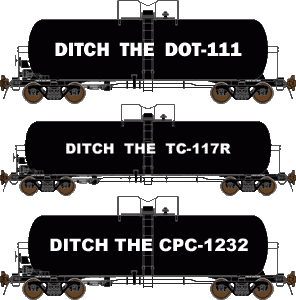
Winnipeg Manitoba - The number of rail accidents involving dangerous goods more than doubled in Canada in 2018.
There were 25 accidents involving dangerous goods in 2018, involving one death, according to Transport Canada (TC) data published Monday.
 There were 11 accidents recorded a year prior, and five in 2016.
There were 11 accidents recorded a year prior, and five in 2016.
These accidents involve dangerous goods, flammable or corrosive substances, that either exploded or leaked.
Seven of the reported incidents involved human error, up from three for each of the previous three years.
Equipment problems made up for four incidents, a number that has been on the rise.
Bruce Campbell, an adjunct professor with York University, said the numbers are small but the increase in overall incidents is concerning.
"It's a pretty big bump," said Campbell, who has written extensively about railway regulation in the wake of the 2013 Lake Megantic rail disaster, in
which the explosion of a runaway oil train killed 47 people.
In Manitoba, there were two accidents in 2018, compared with none for the previous four years.
The data published Monday suggest that despite an apparent up tick in oil moving across Canada by rail, the number of explosions involving crude is trending
downwards.
The number of accidents involving trains carrying either liquefied petroleum gases or gasoline went from 10 in 2016, to none the next year and eight in
2018.
TC qualifies these as "accidents" that companies must report under federal laws.
They do not include near-misses in which there was a risk of dangerous goods leaving their container, instead of accidents, those incidents are known formally
as an "anticipated release."
Monday's data shows a slight up tick in accidents involving trains carrying other chemicals like fuel oil and sodium hydroxide (also known as lye and caustic
soda), though these remain rare.
In November 2016, Ottawa phased out the use of DOT-111 tanks cars for crude oil, as they were considered the least resistant to crashes.
In Canada, those cars will be phased out for all dangerous goods in May 2025.
Campbell speculated that those cars are being used for other dangerous goods in the interim, and that this might account for an overall rise in dangerous-goods
accidents.
John Byrne, vice chairman of the Washington-based Railway Supply Institute's committee on tank cars, said the industry on both sides of the border is phasing
out those cars, based on the models that rail companies are ordering.
Other energy sources are replacing American crude on U.S. rails.
Meanwhile, data from U.S. railways show retrofitted DOT-111 cars are now being used for other flammable liquids like ethanol.
Yet even those shipments see a decline in the proportion of DOT-111 cars being used year over year, since 2013, Byrne pointed out.
It's likely the same in Canada, because the large railways are so integrated with American supply chains.
"You still see significant progress in terms of the fleet transitioning to almost 100 percent, the safer cars," Byrne said.
Documents obtained through American regulators and freedom-of-information requests suggest that the amount of oil moving by rail in Canada has doubled since
2014.
In the Prairies, that number has jumped fourfold, after a spike in January 2019.
Many of those shipments go through Winnipeg, as well as Saskatchewan and northern Ontario.
However, no federal body publicly posts the amount of oil or other dangerous goods moving domestically by rail.
He noted that the arm's-length Transportation Safety Board (TSB) has found that railways need to beef up safety protocols to avoid runaway trains, after a
grain train derailment last year in the Rockies killed three crew members.
Meanwhile, Transport Minister Marc Garneau took both of Canada's large railways to task last July over what he deemed to be lax fatigue management
plans.
"It is troubling," Campbell said.
"All of that is not comforting."
The Alberta government last fall said it plans to allow more rail shipments of crude, beyond the production cap that province imposed in order to stop prices
from tumbling.
The TSB logs dangerous goods accidents differently.
It includes incidents in which there is an injury or damage, involving a train that had transported hazardous goods at any point, even if the cars that
derailed were empty or held other goods.
By the TSB's own definitions, there were 125 accidents involving dangerous goods in 2018, up from 115 a year prior, but below the 10 year average of
129.
The Railway Association of Canada did not respond to a request for comment.
Dylan Robertson.
provisions in Section 29 of the Canadian
Copyright Modernization Act.

